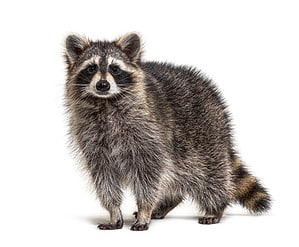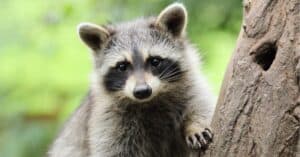The raccoon (Procyon lotor) is one of the most common mammals in North America, living primarily in moist woodlands. Raccoons have black fur masks across their eyes, with bushy tails and rounded ears. They also have sharp teeth, broad skulls, and big hunched backs. Many consider them bandit-like because they look like ninjas and exhibit sneaky behavioral traits. Raccoons are about the size of a small dog, weighing between 14 and 23 pounds. They can become vicious when one approaches them and may attack humans and pets if they feel threatened.

Discover more incredible raccoon facts below:
1. Raccoons Are Agile Tree Climbers
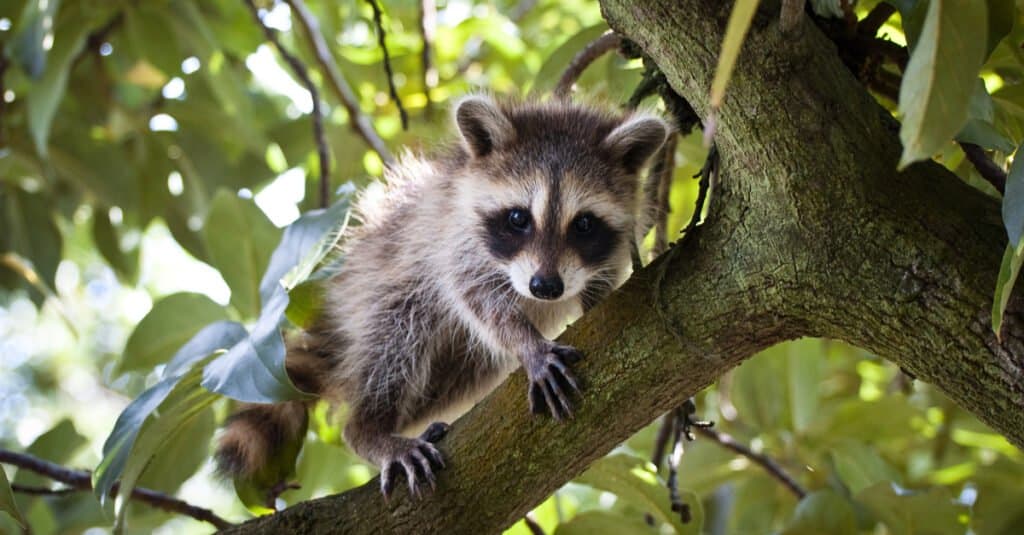
Raccoons climb trees.
©Heiko Kiera/Shutterstock.com
One will almost always find raccoons on the ground, so it’s easy to believe that they never climb trees. That’s because they’re opportunistic scavengers that love to rummage through human refuse or garbage cans. Raccoons are very agile and nimble animals that love to climb trees. They may even climb as high as 40 feet (12 meters), and falling from such elevated heights doesn’t bother them. What makes them such excellent climbers? Their front paws, strong hind legs, long tails, and flexible ankles. These features help them grab on to trees and maintain balance as they climb.
2. Raccoons Are Color Blind

Other than at night, raccoons struggle with seeing.
©O_Medvedeva/Shutterstock.com
That’s right; raccoons have bad eyesight and can’t distinguish colors. However, they do pretty well in discerning green light, and they glow red when a bright light shines in their eyes. Fortunately, what raccoons lose in eyesight, they make up for in other ways.
For example, like cats, raccoons have tapetum lucidum, a reflective layer that gives them excellent night vision. They also have a great sense of smell, touch, and hearing. These factors make them powerful nocturnal animals.
3. Procyon Lotor Means “Before Dog-Washer”
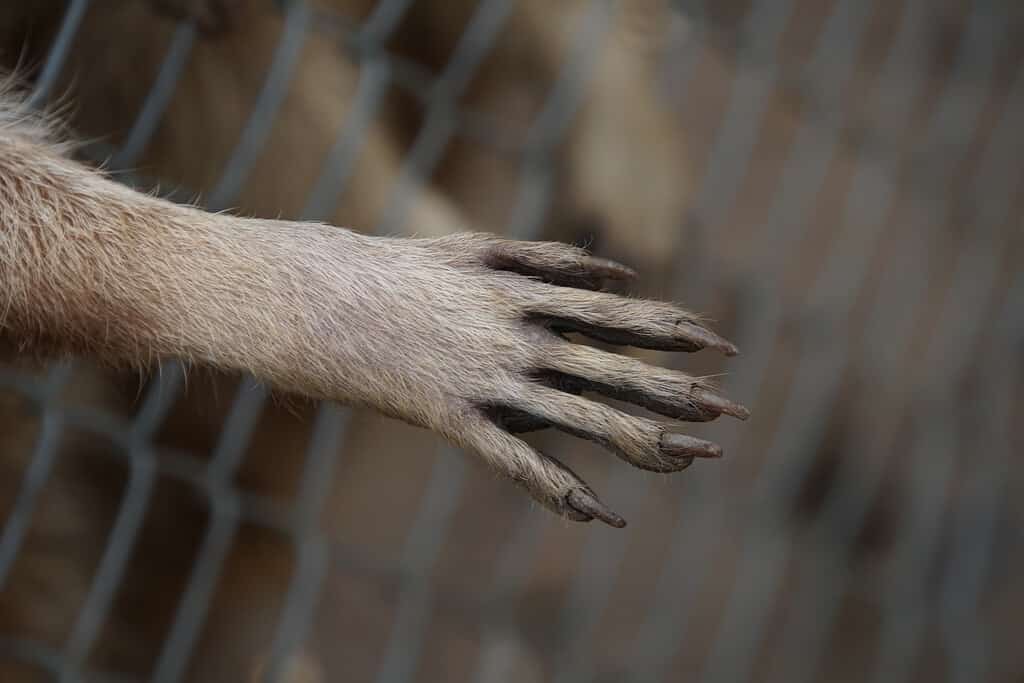
Raccoons tend to wash their food before eating.
©Julija Ogrodowski/Shutterstock.com
Raccoon’s scientific name, “Procyon lotor,” means “before dog-washer.” They got that name because they always wash their food in water before relishing it. These animals have other names in different languages to reflect this washing behavior.
For example, Germans refer to them as waschbär (wash-bear); in Italian, they’re called orsetto lavatore (little washing bear). Meanwhile, the name “raccoon” originates from “aroughcun,” a Powhatan word that means “one that scratches with its hands.” Surprisingly, it’s not true that raccoons wash their food before eating. What people mistake for washing is the animal dousing its hands to increase its sensitivity to touch. This allows them to feel, explore, and memorize their food properly to identify it quickly next time.
4. There Were No Raccoons in Germany Until The 1920s

Germany imported raccoons for fur farms, but they spread in the wild after World War II.
©Hyotographics/Shutterstock.com
Anyone who knows something about Germany knows that the country is overrun with raccoons. Surprisingly, Germany didn’t always have raccoons—at least not until 1920, when Germans started importing them from America. The purpose of their importation was to populate fur farms. During World War II, a stray bomb hit a fur farm, making about two dozen more raccoons populate Germany’s forests. Now, Germans are killing raccoons in their numbers to control their invasion and limit their tendencies to mess vineyards up. These animals also threaten the country’s native birds and turtles, causing auto crashes and diseases.
5. Raccoons Are Highly Intelligent and Inquisitive Animals

The raccoon is, perhaps, the most well-known animal with a mask.
©iStock.com/amadeusamse
If you think foxes are cunning, raccoons can be even more clever. They are among the top ten smartest animals on Earth alongside bees, octopuses, pigeons, pigs, dolphins, crows, elephants, chimpanzees, and humans. In a study, raccoons proved intelligent enough to open 11 of 13 complex locks in a few attempts. Their cleverness makes them unpredictable animals and increases their tendencies for mischief. They pass their intelligence on to their young ones at a tender age. Female raccoons are often seen teaching their young crucial survival skills.
6. The White House Once Had A Presidential Raccoon

Calvin Coolidge became the first U.S. president to convey a message by radio and to keep a raccoon.
©Everett Collection/Shutterstock.com
Many people know of the USA’s presidential German Shepherds pets, Champ and Major. However, few know that the White House once had a presidential raccoon named Rebecca. Rebecca, the raccoon, was US president Calvin Coolidge and First Lady Grace Coolidge’s pet. She came from Mississippi to serve as dinner for 1926’s Thanksgiving in November. Fortunately for Rebecca, President Calvin Coolidge adored her and decided to grant her a pardon and adopt her as a pet. Many say it was because the president had never had a raccoon for a meal and had no intention to try it. Rebecca had an embroidered collar for Christmas with “White House Raccoon” inscribed on it. She enjoyed eggs, her favorite meal at the White House, shrimps, and persimmons.
7. Pygmy Raccoons Are Critically Endangered

Only 300 of these raccoons are assumed to be alive in the wild.
©iStock.com/Sonsedska
Generally, raccoons have their conservation status as “least concern.” However, this is not the case with pygmy raccoons, recorded as critically endangered on the IUCN Red List. At the time of writing this article, one can only find them on Cozumel Island in Mexico. Only about 300 pygmy raccoons are left in the wild, and no one knows the reason for their endangerment apart from their small geographic range. However, the reason may be related to the fact that people keep destroying most woodlands to construct resorts.
8. A Group of Raccoons Is A Gaze or Nursery

Raccoons as a group are known as a Nursery.
“Gaze” or “Nursery” refers to a group of raccoons. However, raccoons are mostly solitary and prefer to live alone. They may form social groups based on sex, and female raccoons may share territories. Raccoons even have communal toilets or latrines where they defecate in their numbers.
A baby raccoon is called a “kit,” male raccoons are “boars,” while a female raccoon is a “sow.”
9. Raccoons Are Not Related To Raccoon Dogs
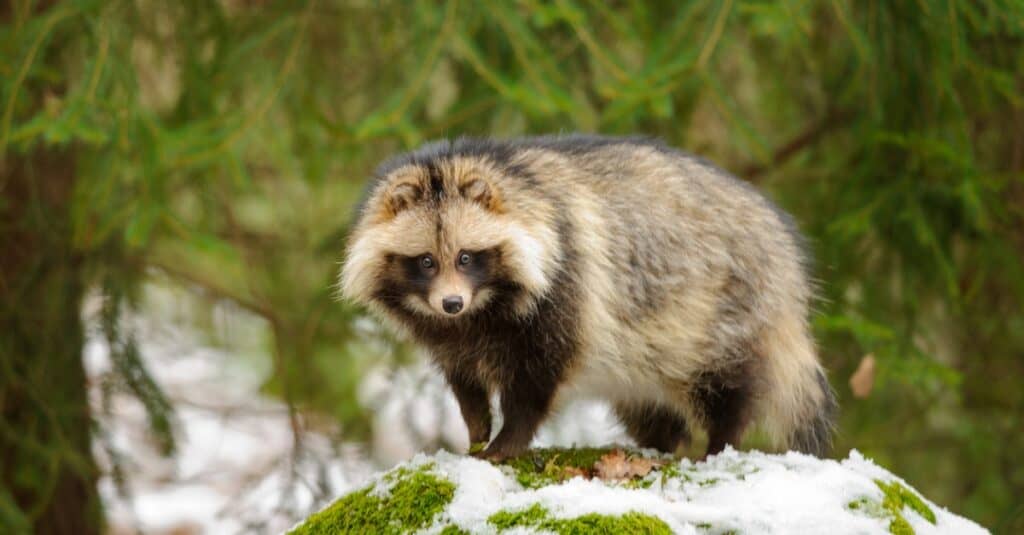
This masked animal is, not surprisingly, commonly mistaken for a raccoon.
©iStock.com/sduben
If you thought that raccoon dogs were related to raccoons, you were wrong. Raccoon dogs have a closer relationship with foxes than raccoons. Many people also wrongly associate raccoons with panda bears and cats.
10. Raccoons Love The City

Don’t be too alarmed if you find a raccoon in a city because it is not too uncommon.
©dschreiber29/ via Getty Images
Raccoons love to live in urban settings and thrive in cities. It makes a lot of sense because they’re intelligent animals that can adapt well to various environments. Generally, urban raccoons are more intelligent than their rural counterparts.
The photo featured at the top of this post is © photofort 77/Shutterstock.com
Thank you for reading! Have some feedback for us? Contact the AZ Animals editorial team.



